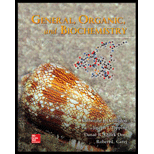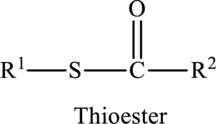
GENERAL ORGANIC+BIOCHEM.-ACCESS>CUSTOM<
10th Edition
ISBN: 9781265799274
Author: Denniston
Publisher: MCG CUSTOM
expand_more
expand_more
format_list_bulleted
Concept explainers
Question
Chapter 14, Problem 14.101QP
Interpretation Introduction
Interpretation:
The thioester bond between the acetyl group and coenzyme A has to be drawn.
Concept Introduction:
Cellular enzymes carry out a reaction between a thiol and a
The general structure of thioester is,

Expert Solution & Answer
Want to see the full answer?
Check out a sample textbook solution
Students have asked these similar questions
A block of zinc has an initial temperature of 94.2 degrees celcius and is immererd in 105 g of water at 21.90 degrees celcius. At thermal equilibrium, the final temperature is 25.20 degrees celcius. What is the mass of the zinc block? Cs(Zn) = 0.390 J/gxdegrees celcius Cs(H2O) = 4.18 J/gx degrees celcus
Potential Energy (kJ)
1. Consider these three reactions as the elementary steps in the mechanism for a chemical reaction.
AH = -950 kJ
AH = 575 kJ
(i) Cl₂ (g) + Pt (s) 2C1 (g) + Pt (s)
Ea = 1550 kJ
(ii) Cl (g)+ CO (g) + Pt (s) → CICO (g) + Pt (s)
(iii) Cl (g) + CICO (g) → Cl₂CO (g)
Ea = 2240 kJ
Ea = 2350 kJ
AH = -825 kJ
2600
2400
2200
2000
1800
1600
1400
1200
1000
a. Draw the potential energy diagram for the reaction. Label the data points for clarity.
The potential energy of the reactants is 600 kJ
800
600
400
200
0
-200-
-400
-600-
-800-
Reaction Progress
Can u help me figure out the reaction mechanisms for these, idk where to even start
Chapter 14 Solutions
GENERAL ORGANIC+BIOCHEM.-ACCESS>CUSTOM<
Ch. 14.1 - Assuming that each of the following pairs of...Ch. 14.1 - Assuming that each of the following pairs of...Ch. 14.1 - Prob. 14.3QCh. 14.1 - Why would you predict that a carboxylic acid would...Ch. 14.1 - Prob. 14.1PPCh. 14.1 - Prob. 14.5QCh. 14.1 - Prob. 14.6QCh. 14.1 - Prob. 14.2PPCh. 14.1 - Prob. 14.3PPCh. 14.1 - Prob. 14.4PP
Ch. 14.1 - Prob. 14.5PPCh. 14.1 - Prob. 14.6PPCh. 14.2 - Prob. 14.7PPCh. 14.2 - Prob. 14.8PPCh. 14.2 - Prob. 14.9PPCh. 14.2 - Prob. 14.7QCh. 14.2 - Prob. 14.8QCh. 14.3 - Prob. 14.10PPCh. 14.3 - Write the common and IUPAC names for each of the...Ch. 14.3 - Prob. 14.9QCh. 14.3 - Prob. 14.10QCh. 14 - Prob. 14.11QPCh. 14 - Prob. 14.12QPCh. 14 - Prob. 14.13QPCh. 14 - Prob. 14.14QPCh. 14 - Prob. 14.15QPCh. 14 - Prob. 14.16QPCh. 14 - Prob. 14.17QPCh. 14 - Which member in each of the following pairs is...Ch. 14 - Prob. 14.19QPCh. 14 - Prob. 14.20QPCh. 14 - Prob. 14.21QPCh. 14 - Prob. 14.22QPCh. 14 - Prob. 14.23QPCh. 14 - Prob. 14.24QPCh. 14 - Prob. 14.25QPCh. 14 - Prob. 14.26QPCh. 14 - Prob. 14.27QPCh. 14 - Prob. 14.28QPCh. 14 - Prob. 14.29QPCh. 14 - Prob. 14.30QPCh. 14 - Prob. 14.31QPCh. 14 - Prob. 14.32QPCh. 14 - Prob. 14.33QPCh. 14 - Prob. 14.34QPCh. 14 - Prob. 14.35QPCh. 14 - Prob. 14.36QPCh. 14 - Prob. 14.37QPCh. 14 - Prob. 14.38QPCh. 14 - Prob. 14.39QPCh. 14 - Prob. 14.40QPCh. 14 - Prob. 14.41QPCh. 14 - Prob. 14.42QPCh. 14 - Prob. 14.43QPCh. 14 - Prob. 14.44QPCh. 14 - Prob. 14.45QPCh. 14 - Prob. 14.46QPCh. 14 - Prob. 14.47QPCh. 14 - Prob. 14.48QPCh. 14 - Write an equation representing the oxidation of...Ch. 14 - Prob. 14.50QPCh. 14 - Prob. 14.51QPCh. 14 - Prob. 14.52QPCh. 14 - Prob. 14.54QPCh. 14 - Write an equation representing the neutralization...Ch. 14 - Prob. 14.56QPCh. 14 - Prob. 14.57QPCh. 14 - Prob. 14.58QPCh. 14 - Prob. 14.59QPCh. 14 - Prob. 14.60QPCh. 14 - Prob. 14.61QPCh. 14 - Prob. 14.62QPCh. 14 - Prob. 14.63QPCh. 14 - Draw condensed formulas for each of the following...Ch. 14 - Prob. 14.65QPCh. 14 - Prob. 14.66QPCh. 14 - Prob. 14.67QPCh. 14 - Prob. 14.68QPCh. 14 - Prob. 14.69QPCh. 14 - Prob. 14.70QPCh. 14 - Prob. 14.71QPCh. 14 - Prob. 14.72QPCh. 14 - Prob. 14.73QPCh. 14 - Prob. 14.74QPCh. 14 - Prob. 14.75QPCh. 14 - Prob. 14.76QPCh. 14 - Prob. 14.77QPCh. 14 - Prob. 14.78QPCh. 14 - Prob. 14.79QPCh. 14 - Prob. 14.80QPCh. 14 - Prob. 14.81QPCh. 14 - Prob. 14.82QPCh. 14 - Prob. 14.83QPCh. 14 - Prob. 14.84QPCh. 14 - Prob. 14.85QPCh. 14 - Prob. 14.86QPCh. 14 - Prob. 14.87QPCh. 14 - Prob. 14.88QPCh. 14 - Prob. 14.89QPCh. 14 - Prob. 14.90QPCh. 14 - Prob. 14.91QPCh. 14 - Prob. 14.92QPCh. 14 - Prob. 14.93QPCh. 14 - Prob. 14.94QPCh. 14 - Prob. 14.95QPCh. 14 - Prob. 14.96QPCh. 14 - Prob. 14.97QPCh. 14 - What is meant by a phosphoanhydride bond?
Ch. 14 - Prob. 14.99QPCh. 14 - Prob. 14.100QPCh. 14 - Prob. 14.101QPCh. 14 - Prob. 14.102QPCh. 14 - Prob. 14.103QPCh. 14 - Prob. 2MCPCh. 14 - Consider the Chapter Map, and explain the...Ch. 14 - Prob. 4MCPCh. 14 - Prob. 6MCPCh. 14 - Triglycerides are the major lipid storage form in...Ch. 14 - Prob. 10MCPCh. 14 - Acetyl coenzyme A (acetyl CoA) can serve as a...Ch. 14 - Prob. 12MCP
Knowledge Booster
Learn more about
Need a deep-dive on the concept behind this application? Look no further. Learn more about this topic, chemistry and related others by exploring similar questions and additional content below.Similar questions
- Hi, I need your help with the drawing, please. I have attached the question along with my lab instructions. Please use the reaction from the lab only, as we are not allowed to use outside sources. Thank you!arrow_forwardHi, I need your help i dont know which one to draw please. I’ve attached the question along with my lab instructions. Please use the reaction from the lab only, as we are not allowed to use outside sources. Thank you!arrow_forward5. Write the formation reaction of the following complex compounds from the following reactants: 6. AgNO₃ + K₂CrO₂ + NH₄OH → 7. HgNO₃ + excess KI → 8. Al(NO₃)₃ + excess NaOH →arrow_forward
- Indicate whether the product formed in the reaction exhibits tautomerism. If so, draw the structure of the tautomers. CO₂C2H5 + CH3-NH-NH,arrow_forwardDraw the major product of this reaction N-(cyclohex-1-en-1-yl)-1-(pyrrolidino) reacts with CH2=CHCHO, heat, H3O+arrow_forwardDraw the starting material that would be needed to make this product through an intramolecular Dieckmann reactionarrow_forward
- Draw the major product of this reaction. Nitropropane reacts + pent-3-en-2-one reacts with NaOCH2CH3, CH3CHOHarrow_forwardIndicate whether the product formed in the reaction exhibits tautomerism. If so, draw the structure of the tautomers. OC2H5 + CoHs-NH-NH,arrow_forwardExplain how substitutions at the 5-position of barbituric acid increase the compound's lipophilicity.arrow_forward
- Explain how substitutions at the 5-position of phenobarbital increase the compound's lipophilicity.arrow_forwardName an interesting derivative of barbituric acid, describing its structure.arrow_forwardBriefly describe the synthesis mechanism of barbituric acid from the condensation of urea with a β-diketone.arrow_forward
arrow_back_ios
SEE MORE QUESTIONS
arrow_forward_ios
Recommended textbooks for you
 ChemistryChemistryISBN:9781305957404Author:Steven S. Zumdahl, Susan A. Zumdahl, Donald J. DeCostePublisher:Cengage Learning
ChemistryChemistryISBN:9781305957404Author:Steven S. Zumdahl, Susan A. Zumdahl, Donald J. DeCostePublisher:Cengage Learning ChemistryChemistryISBN:9781259911156Author:Raymond Chang Dr., Jason Overby ProfessorPublisher:McGraw-Hill Education
ChemistryChemistryISBN:9781259911156Author:Raymond Chang Dr., Jason Overby ProfessorPublisher:McGraw-Hill Education Principles of Instrumental AnalysisChemistryISBN:9781305577213Author:Douglas A. Skoog, F. James Holler, Stanley R. CrouchPublisher:Cengage Learning
Principles of Instrumental AnalysisChemistryISBN:9781305577213Author:Douglas A. Skoog, F. James Holler, Stanley R. CrouchPublisher:Cengage Learning Organic ChemistryChemistryISBN:9780078021558Author:Janice Gorzynski Smith Dr.Publisher:McGraw-Hill Education
Organic ChemistryChemistryISBN:9780078021558Author:Janice Gorzynski Smith Dr.Publisher:McGraw-Hill Education Chemistry: Principles and ReactionsChemistryISBN:9781305079373Author:William L. Masterton, Cecile N. HurleyPublisher:Cengage Learning
Chemistry: Principles and ReactionsChemistryISBN:9781305079373Author:William L. Masterton, Cecile N. HurleyPublisher:Cengage Learning Elementary Principles of Chemical Processes, Bind...ChemistryISBN:9781118431221Author:Richard M. Felder, Ronald W. Rousseau, Lisa G. BullardPublisher:WILEY
Elementary Principles of Chemical Processes, Bind...ChemistryISBN:9781118431221Author:Richard M. Felder, Ronald W. Rousseau, Lisa G. BullardPublisher:WILEY

Chemistry
Chemistry
ISBN:9781305957404
Author:Steven S. Zumdahl, Susan A. Zumdahl, Donald J. DeCoste
Publisher:Cengage Learning

Chemistry
Chemistry
ISBN:9781259911156
Author:Raymond Chang Dr., Jason Overby Professor
Publisher:McGraw-Hill Education

Principles of Instrumental Analysis
Chemistry
ISBN:9781305577213
Author:Douglas A. Skoog, F. James Holler, Stanley R. Crouch
Publisher:Cengage Learning

Organic Chemistry
Chemistry
ISBN:9780078021558
Author:Janice Gorzynski Smith Dr.
Publisher:McGraw-Hill Education

Chemistry: Principles and Reactions
Chemistry
ISBN:9781305079373
Author:William L. Masterton, Cecile N. Hurley
Publisher:Cengage Learning

Elementary Principles of Chemical Processes, Bind...
Chemistry
ISBN:9781118431221
Author:Richard M. Felder, Ronald W. Rousseau, Lisa G. Bullard
Publisher:WILEY